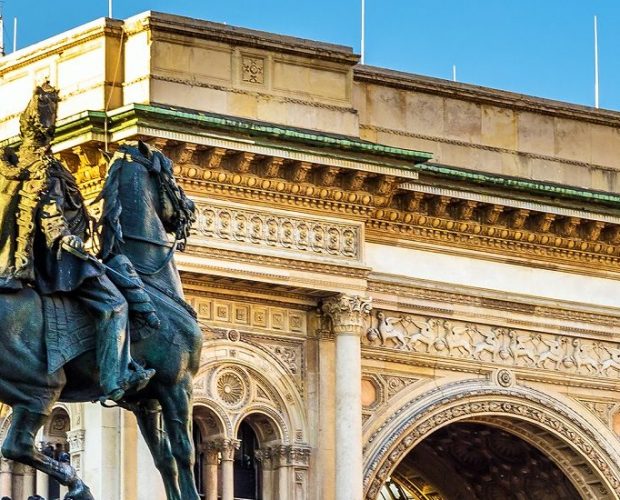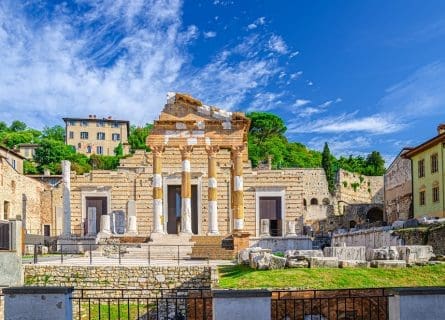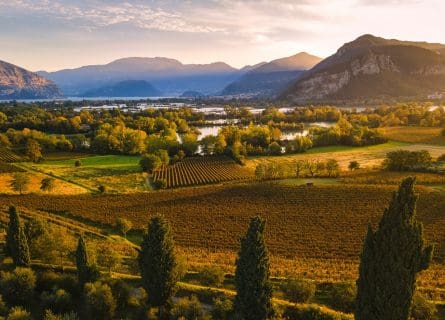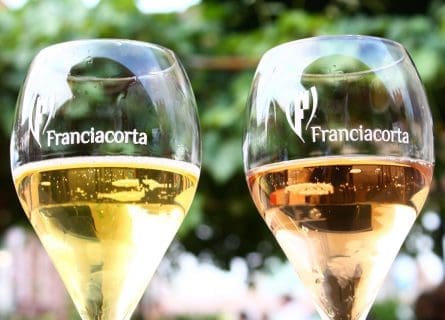Italy's fashion capital blending history and modernity. Explore art, architecture, upscale dining, boutique shopping, and cultural richness.
Read more
EXPLORE ALL OUR LOMBARDY WINE REGION GUIDE
Last updated: June 5, 2025
The standard approach to Franciacorta is to describe it as “an Italian facsimile of Champagne.” This generalization works up to a point: the appellation is renowned for its traditional-method sparkling wines, typically involving blends of Chardonnay and Pinot Noir. Similarly, Champagne has a culture of long aging for the best cuvées, producing wines of incredible depth and complexity. And, like Champagne, the crème de la crème of Franciacorta is seldom cheap.
There are significant differences in terroir, climate, and philosophy when comparing Franciacorta to France’s premier sparkling wine region. The area under vine in Franciacorta is relatively small, about one-tenth the size of that renowned French vineyard. Furthermore, Franciacorta is still carving out its niche in export markets, unlike its well-established Gallic counterpart, and notably, Pinot Meunier is absent in its blends. Describing Franciacorta merely as a “Champagne imitation” dramatically underestimates the region. Franciacorta is a winegrowing area with a distinct history and cultural identity, proud and focused on quality, and it does not play second fiddle to any other region.

In 222 BC, the Romans founded Mediolanum (Milan) in Lombardy’s rich, fertile landscape. Three years earlier, the city of Brescia had submitted to Roman authority – this would become the center of sparkling wine production in the region, albeit the first bottles did not start to appear until the 20th century. But winegrowing has taken place since the ancient era, and Brescia’s wines were extolled in the writings of Pliny the Elder, Columella, and Virgil.
Indeed, both Mediolanum and Brescia played a key role in Rome’s political history; the Visigoths attacked the latter in the early 5th century, followed by Atilla the Hun and the Ostrogoths. By AD 476, the Western Roman Empire was in ruins, and chaos reigned.
In the 6th century, however, the Lombards captured Brescia, and a period of relative stability returned. As the capital of a semi-independent duchy, the city flourished as a major center of trade and commerce in Lombardy. Yet, in 774, the First Holy Roman Emperor Charlemagne pushed the Lombards out of northern Italy at the behest of the Catholic Church. This once-provincial city became the de facto capital of the Holy Roman Empire under the direction of Louis II the Younger. Meanwhile, the surrounding vineyards of Franciacorta were renowned for producing “frizzante” wines in the Middle Ages, effervescent rather than sparkling in the sense we think of them today. Nonetheless, they inspired the first book ever written on sparkling beverages; Brescian physician Geronimo Conforto wrote the book Libellus de Vino Mordaci in 1570. He used the adjective “mordace” or “biting” to describe the wines of Franciacorta.
However, the origins of the nomenclature remain uncertain. There are two predominant theories regarding the etymology of the word Franciacorta: the first is that it is named for the “france corte” or tax-free zones, which it encompassed. The area was inhabited by religious orders in the eleventh, twelfth, and thirteenth centuries that were not subjected to the taxes of the ruling Brescians. Yet historian Lacopo Malvezzi believes that Charlemagne named the area in the 8th century. In 744, the Frankish king found himself near the town of Rodengo Saiano on the feast day of San Dionigi; however, he had promised to spend that day in Paris. Charlemagne called the area “little France,” hence Franciacorta to alleviate his conscience.
The first traditional-method wines were produced by Guido Berlucchi’s winemaker, Franco Zilani, in 1961. Doing so at the time seemed utterly pointless, however, as the wines of Franciacorta were all still and consumed in the immediate area, which was mainly a vacation area for wealthy Brescians. But, when Berlucchi tasted the fruits of Zilani’s labors, he realized the potential of Franciacorta for high-quality sparkling wine production, and the history of viticulture was changed. Along with a handful of other producers like Bellavista and Ca’ del Bosco, their vision – and wealth – enabled them to build this unique sparkling wine-only appellation based solely on the principle of quality. Franciacorta was subsequently elevated to DOCG (Denominazione di Origine Controllata e Garantita) in 1995.

Franciacorta is a relatively small appellation encompassing 3000 hectares under vine, shared among 200 growers. It is situated 70km east of Milan, at the foot of the Italian Alps. Geologically, the zone results from glacial activity, which descended upon the Val Camonica and shaped it. As a result of this activity, many minerals were deposited here, which sit atop the substratum. These minerals are essential in viticulture – critical for wine aromas and soil drainage. It is one of the reasons why Franciacorta is celebrated as a premium terroir for still and sparkling wines in Lombardy.
It is also extraordinarily beautiful. The vineyards are planted on an amphitheater-shaped chain of hills near Lake Iseo that protect the valley from southern winds. Climatically, Franciacorta is much milder in the winter than most sub-alpine zones, while summers are relatively hot and dry. Over 64 soil types have been identified within the appellation boundaries, including calcareous, sandy soils, and rock fragments deposited by glacier movements. As a result of this soil diversity, there are plenty of blending options in Franciacorta; growers seek out the coolest sites to maintain acidity and freshness in their wines.
Chardonnay is the most prominent variety in Franciacorta, followed by Pinot Noir and Pinot Bianco. The latter came to the region long before Chardonnay; however, it is declining in importance as winemakers continue to prioritize Champagne’s leading duo. There have also been some experiments with Erbamat, an indigenous white grape that yields high-acid base wines that are increasingly useful in the fight against climate change.

Franciacorta is relatively straightforward to understand, having taken inspiration from the French regarding winemaking and production rules. Moreover, like Champagne, Franciacorta is produced as a non-vintage and vintage style, available at various price points; white and rosé wines are made, and the latter must contain at least 25% Pinot Noir.
But most labels are blends of Chardonnay, Pinot Noir, and possibly Pinot Bianco (maximum 50 percent), marketed as a Brut style. Yet while Champagne insists on a minimum aging period of 15 months on the lees, Franciacorta requires 18 months as standard. There are also many zero-dosage wines on the market, more than you would typically find in Champagne.
However, Franciacorta is made broadly like its Gallic cousin regarding production methods. After the grapes have been harvested and the wines have been fermented, bottles are filled with the wine and a yeast/sugar concoction known as liqueur de tirage. The yeast will then cause a secondary fermentation in the bottle, which eats up the sugar, releasing carbon dioxide into the solution.
The wine is then left in contact with the yeasty sediment, or lees, for the legally defined minimum period. During the aging process, the bottles are turned occasionally, causing the residual yeast to collect in the neck of the bottle. After sufficient aging, the yeast is removed from the bottle with a process known as disgorging and is then re-corked.
Of course, what emerges in your glass can vary dramatically, depending on the period of lees aging, the brand in question, and the specific blend. Indeed, styles range from light and airy to vinous and rich; however, very few poor wines are being made in Franciacorta today. One of the most popular categories is Saten – the local name for Blanc de Blancs sparkling wine. Created by Mattia Vezzola, winemaker at Bellavista, this gorgeous interpretation of local terroir is bottled under less pressure than NV Franciacorta Brut; the smoothness and elegance of such wine have won it massive favor abroad. For many consumers, Saten is Franciacorta.
Franciacorta is one of Italy’s greatest, if not the greatest, success stories. Are we being hyperbolic? Not at all: Few regions have established themselves to this extent in less than 60 years. Well-known—and more popular than Champagne in Italy—Franciacorta is a triumph of shrewd, intelligent marketing.
Yet the appellation is centered upon high quality rather than promotional gimmicks and celebrity endorsements. Much smaller than its rival in France, Franciacorta has maintained an admirable focus on consistency of output, with few lackluster brands. Moreover, the sustainability movement is in full swing – over 2000 hectares of vineyards are either certified as organic or are undergoing conversion in the zone.
“Some of the most important trends in Franciacorta are sustainability, low dosage, and indigenous varieties,” said Silvano Brescianini, president of Consorzio Franciacorta. “The region has been focusing on sustainability and biodiversity for many years; in 2012 we certified the carbon footprint of the region and more than 50% of our vineyards are organic. We are also undertaking a new study on biodiversity, and we have an ambitious project regarding the zoning. Regarding the trend of grape varieties, we have recently introduced Erbamat, an indigenous grape present in Brescia already 5 centuries ago, and we are continuing to study it.”
It is also a region that can successfully market (unlike Cava) prestige cuvées at Dom Perignon prices. All agree that Cuvée Anna-Maria Clementi is in a league of its own, produced by the legendary house Ca’ Del Bosco. To quote sparkling wine expert Essi Avellan MW: “Anna-Maria Clementi is unmatched in quality by any Italian sparkling wine. Stunningly rich and caressingly velvet-smooth with superb coffee and toast notes over lemon and many other delicious nuances. Today, it is better than ever.” But Franciacorta has growing competition, not least from fierce rival Bellavista.
Meanwhile, Brescia’s tourist infrastructure continues its expansion, with new tasting rooms, restaurants, and luxury hotels opening at a cracking pace. Today, visitors can expect a glorious surprise in its sparkling wines’ quality, variety, and value. But, unlike 20 years ago, these superlative bottles can now be enjoyed on-site, with spectacular views of the vineyards.
Are there any challenges on the horizon? Absolutely – relatively little Franciacorta is exported, which the conzorzio seeks to change. The rest of the world should, of course, seize the opportunity with both hands. Franciacorta is a tremendous alternative to Champagne and the perfect excuse to add a little Italian flair to your wine cellar.
Chardonnay is a green-skinned grape varietal native to the Burgundy wine region in France and one of the most popular varieties worldwide.
Find out moreThe Erbamat grape variety, known since the 15th century, is being used by Franciacorta DOC producers in Lombardy, Italy, to combat the effects of climate change. This late-ripening grape yields high amounts, low alcohol, substantial acidity, and a relatively neutral aroma. The Franciacorta Consortium authorized its use in 2019, permitting up to 10% in sparkling wine blends.
Explore Pinot Bianco: Shaping Excellence in Franciacorta & Alto Adige Wines. Versatile and Unique Grape, Unveil Its Secrets!"
Find out morePinot noir is a light-bodied red wine varietal closely related to the Vitis vinifera grape and produces the most sought-after red wines in the world.
Find out moreBrescia’s restaurants conjure times past, emphasizing traditional recipes, seasonal ingredients, and no fuss. But despite the advent of molecular gastronomy, many visitors delight in the lively atmosphere of a family-run trattoria – a thriving and satisfying part of daily life in the region. Uccelli scappati is a local highlight: veal cutlets rolled in pancetta and sage before being sautéed in butter and white wine. Meanwhile, pasta lovers will go nuts over Casoncelli di Barbariga, a traditional Brescian pasta dish of parcels filled with breadcrumbs, hard cheese, Parma ham, spinach, garlic, sage, and butter. Enjoy it with a chilled glass of Saten, and your evening will be complete.
Guide to the Gastronomy and Cusine of Lombardy: Read more
If you would like us to customize an exclusive luxury tour, contact us and let us know your travel plans. We offer luxury food and wine tours for private groups of a minimum two guests. In addition, all of our private, chauffeured tours are available year-round upon request.

